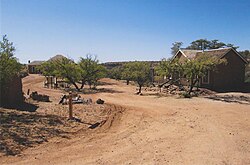Kentucky Camp, Arizona
|
Kentucky Camp Historic District
|
|

Kentucky Camp in 2014.
|
|
|
Location in the state of Arizona
|
|
| Location | Santa Rita Mountains, Arizona, USA |
|---|---|
| Nearest city | Sonoita, Arizona |
| Coordinates | 31°44′13″N 110°43′43″W / 31.73694°N 110.72861°WCoordinates: 31°44′13″N 110°43′43″W / 31.73694°N 110.72861°W |
| Area | 340 acres (140 ha) |
| Built | 1905 |
| Architect | George B. McAneny; James B. Stetson |
| NRHP Reference # | 95001312 |
| Added to NRHP | November 22, 1995 |
Kentucky Camp is a ghost town and former mining camp along the Arizona Trail in Pima County, Arizona, United States, near the community of Sonoita. The Kentucky Camp Historic District is listed on the National Register of Historic Places and has been since 1995. As it is located within Coronado National Forest, the United States Forest Service is responsible for the upkeep of the remaining buildings within the Kentucky Camp Historic District.
A freak accident that killed a mining engineer allowed Kentucky Camp to persist as it is today, a scenic canyon dotted with mesquites, oaks, tall grasses and cacti. The plans for the Kentucky Camp area in the realm of gold mining were ambitious but never really came to fruition.
In 1874 gold was discovered on the eastern slope of the Santa Rita Mountains. The area became known as the Greaterville mining district and proved to be one of the richest placer deposits in southern Arizona. Placer deposits consist of a mixture of gold, sand and gravel; to separate the substances, water is required. Generally, water is readily available to wash the mixture of sand, gravel, and gold. However, the arroyos of the Santa Rita Mountains are dry. Miners were required to haul the sacks of dirt to the few running streams in the area. Sometimes they would carry packed water, in canvas and goatskin bags, on the backs of burros to their claims. By 1886, much of the rich deposits that were worth such an effort were worked out and many miners gave up and moved on.
In 1902 a California mining engineer, James Stetson, had an idea to solve the water problem. His scheme involved channeling seasonal runoff from the mountain streams into a reservoir that would hold enough water to last ten months allowing him to keep a mine in operation. Stetson was able to convince a wealthy Californian, George McAneny to invest in his plan and with other investors from Tucson they formed the Santa Rita Water and Mining Company. The pair prospected the area of Greaterville and finally settled on a mining site in Boston Gulch. The headquarters was set up at nearby Kentucky Gulch and from 1902 until 1906, the buildings at Kentucky Camp served as the offices and residences for the mine employees.
...
Wikipedia


